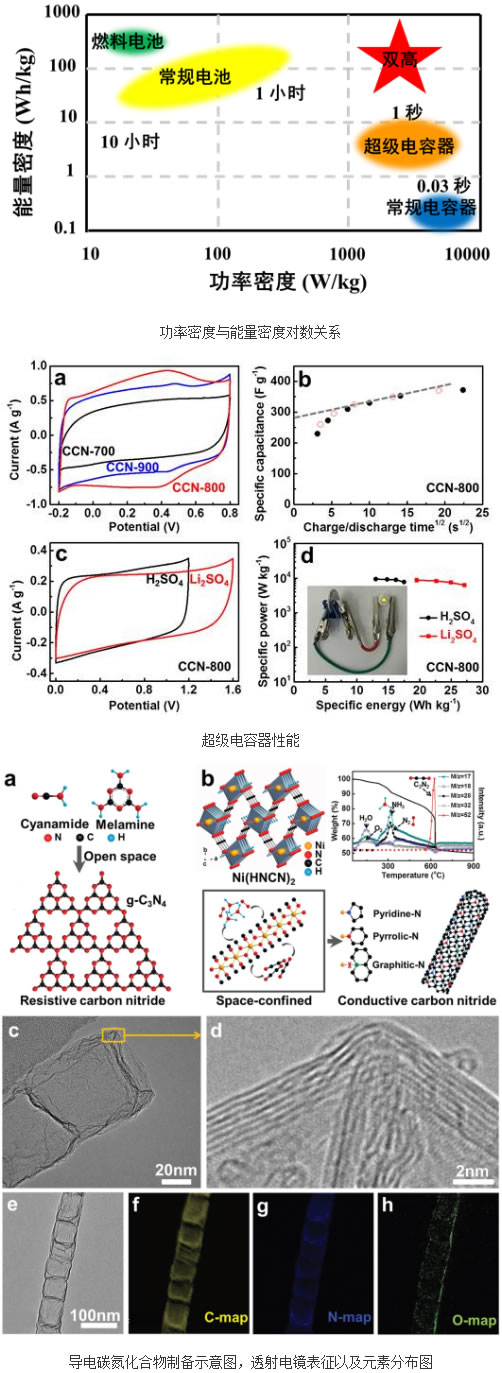Recently, Shanghai Institute of Ceramics, Chinese Academy of Sciences, cooperated with Zhejiang University, Peking University, etc. and successfully prepared a new type of conductive carbon-nitrogen compound. The material is rich in mesoporous and microporous structure, with nitrogen content as high as ~15 at% and excellent conductivity >2S cm−1. It exhibits excellent rate performance and cycle stability in ultracapacitor electrode materials and specific capacity. Up to 372 F g−1, much higher than commercial activated carbon materials (<250 F g−1). The research results were published on the June 19th issue of Advanced Materials (DOI: 10.1002/adma.201701674) with the theme of "Conductive Carbon Nitride for Excellent Energy Storage". Shanghai Silicate Institute and Zhejiang University jointly cultivated graduate students. Xu Jijian and Shanghai silicate graduate student Xu Feng are co-first authors. Huang Fuqiang, a fellow at the Shanghai Silicate Institute, is the author of the correspondence.
High-quality modern life requires extremely convenient electronic products, such as high-efficiency chemical power supplies that are rapidly needed to enable electric vehicles to run far and mobile phones have a long standby time. Current commercial advanced energy storage devices mainly include lithium ion batteries and super capacitors. The former has a high energy density and the latter has a high power density. However, they cannot meet the urgent requirements of "double high" applications. The key to breaking through this "double height" bottleneck is to develop a new electrode material with a very high surface tantalum capacitance response. Carbon-based materials are widely used in lithium-ion batteries and supercapacitors, and are still regarded as the most promising "double-high" electrode materials. The latest developments have become the focus of international research and development.
For the "double high" new carbon-based electrode materials, the consensus reached in recent years is that they have high nitrogen content, high specific surface area, and high electrical conductivity. The doped nitrogen atoms incorporate effective tantalum capacitors based on redox reactions. The high specific surface area ensures a large number of double-layer capacitances, while the high conductivity ensures excellent rate-of-charge transfer. Common graphene has high electronic conductivity, but it is difficult to achieve a high nitrogen content and a serious lack of redox active sites. The graphene-like carbon-nitrogen material g-C3N4 has a very high nitrogen content of ~57%, whereas its high bandgap (~2.7 eV) results in extremely poor electron transport capability. Therefore, it is a challenge to prepare novel conductive carbon-nitrogen compounds with high nitrogen content, high electrical conductivity, and high specific surface area.
Researchers have designed a new type of conductive carbon-nitrogen compound through space-limited autocatalytic reaction design. In a spatially limited reaction, a unique precursor of nickel cyanohydrin is decomposed to produce metallic nickel as a catalyst for the growth of conductive sp2 carbon, and a xN=C=N* or NoC-CoN group as a carbon source and a nitrogen source. At the same time, Ni-N bonds in nickel cyanohydrin favor the stable presence of nitrogen atoms. A high heat treatment temperature can increase the conductivity but reduce the nitrogen content. Thus by adjusting the reaction temperature, the nitrogen content and conductivity can be further balanced. At 800°C, carbon sp2 hybridizes up to 60% to have a conductivity of 2.3 S cm−1, nitrogen content up to 15 at%, and especially electrochemically active pyridine nitrogen and pyrrolium up to 9 at % and 5 at %. This simple and easy-to-scale production method has great industrial application value, and it also provides a new idea for designing and synthesizing other new types of energy storage materials.
The study was supported by major research projects of the State, the National Natural Science Foundation of China, the Shanghai Science and Technology Commission and the Chinese Academy of Sciences.

Springs classified by material
Springs Classified By Material,Brass Spring,Nickel Plated Spring,Tinned Spring
Dongguan Jiufukai Hardware Products Co., Ltd , https://www.jfkspring.com